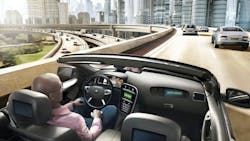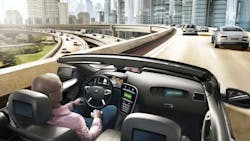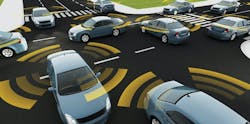Taking the long view
When you talk about driverless cars, images of Knight Rider’s KITT car or scenes from the science fiction film “Minority Report” may come to mind. While it is hard to wrap your head around the idea of getting into a vehicle without a driver, significant public discussion and substantial private investments are accelerating automated vehicles.
Former U.S. Transportation Secretary Anthony Foxx has said fully autonomous cars will be available to consumers within the next 10 years. And Business Insider published a report in October 2016 that reviewed 19 major companies claiming to put self-driving cars on the road by the year 2021. That may seem like it is much farther off in the future, but that is only five years from now. Think how fast five years goes by in your life (of course, that depends on your age).
What is clear is that the next decade will usher in the Era of Driverless Cars—assuming the U.S. DOT, as well as local and state jurisdictions, put regulations in place.
The reality is that these new vehicles will likely drive massive disruption, forcing real-estate investors and developers to re-examine their strategies. For example, Houston’s central business district is comprised of 65% streets and surface parking with only 35% for buildings and parks.
Even in Washington, D.C., which has a sizable mass transit system, streets and parking take up 45% of the downtown central business district, and cars can occupy substantial space within buildings—upwards of 30%.
It is hoped that driverless vehicles will reduce the need for car-related space, relieve congestion, reduce fuel use, and lower the number of accidents. The likely advent of these vehicles means real-estate owners and investors should start paying attention now. But how will driverless cars affect real-estate usage and values, and thus community development?
Less need for space
There is a lot of discussion going on as to whether or not the need for parking will drop, increase or stay the same. A variety of experts and analysts are weighing in on this issue. Most recently, Deloitte LLP’s leader of global and U.S. real estate Bob O’Brien told Law360 that investors are already planning for a time when large parking garages are simply not needed.
A report by Green Street Advisors, a California-based research firm, estimates that a decline in vehicle ownership could cut U.S. parking needs in half within 30 years. That would eliminate 75 billion sq ft of parking space. To put it in perspective, this is more than the combined area of all apartment, office, shopping mall, retail strip center and warehouse buildings in the country today.
What does that mean? It means that values of parking garages and parking lots will plummet. It also appears that some above-ground parking garage structures will be repurposed, but many also will become obsolete because of floor-to-floor dimensions. Parking components for high-rise apartment buildings, which comprise as much as 15-20% of construction costs, will likely become unnecessary or at least be reduced. This reduction in cost will increase developer returns or allow for a reduction in rental costs by as much as 30%. An ancillary benefit of this could be to make it much easier and cheaper for small businesses to develop and thrive in urban and suburban centers, and the increase in commerce could then lead to more dynamic infrastructure developments.
Bikes and urban green space
If indeed private vehicle ownership will decline, then the need for parking along roads will decline, making many more neighborhood streets twice as wide as needed. Parking lanes on streets could be converted to bicycle and scooter lanes, while some streets could be repurposed into green spaces, decreasing water runoff and heat buildup. San Francisco already has programs that allow residents to repurpose street parking into mini public spaces or very small parks and patios, called “parklets.” Converting a fraction of San Francisco’s 280,000 parking spaces (which represents 40 million sq ft) could result in significant changes in residential and retail markets in San Francisco—to say nothing of making neighborhoods more amenable and friendly to their denizens.
Transportation authorities estimate that driverless vehicles will be available to consumers within the next 10 years.
The need for data centers
Even without driverless cars, the need for data centers is increasing daily. As a fleet of hundreds of millions of vehicles transition into sophisticated mobile computer-driven telecommunication devices (to wit: a computer server on wheels), the already extraordinary demand for data-center space will grow. Automated cars use almost one gigabyte of data every second. There will likely be an increasing need for office space for high-tech and creative professionals who create the software and designs for self-driving vehicles. This boon to the technology segment will have nationwide ramifications.
Autonomous cars operating as fleets maintained and refueled at central locations will make the new corner gas station and convenience store potentially obsolete. It is expected in the future that privately owned autonomous cars will be programmed to refuel on their own. The same process is used in robotic garages that are slowly being built in the U.S. It has been noted that, as of 2012, the nation as a whole had more than 125,000 gas stations and convenience stores, many of which are sited on busy intersections and are therefore (potentially) suitable for redevelopment.
TODs
A recent CBRE study determined that office towers adjacent to subway stations in Manhattan receive up to a 19% rent premium over buildings only two blocks away. Some in the real-estate industry believe these types of premiums could ultimately diminish and some transit station properties may even lose their relative-value edge entirely. Could Transit Oriented Developments (TODs) actually decrease? It is extremely difficult to forecast the changes in real estate.
But the desirability of living close to mass transit may increase, because people may be more willing to abandon their cars and depend on the ready availability of driverless cars if they know they are able to conveniently move around on subways, light rail or buses. We see this already happening today with Millennials in cities and urbanized areas. In Washington, D.C., parking for new apartment facilities equals 0.33 spaces per unit. In Baltimore, the demand for parking is lessening to about one space per unit.
When asked to account for why this decrease is taking place, major developers have indicated that urban mobility companies such as Uber and Lyft have created a market that results in Millennials simply not wanting or needing a car.
Suburban and rural residential property
There also is the question of rural property. Commuting long distances from the suburbs to central business districts will likely become more feasible for people because of faster and more efficient drive times; moreover, people also will now have the ability to do other things while a driverless car is taking them to their final destination—catch up on work or sleep, have their breakfast, read a good book, all while the vehicle’s GPS-based software systems find the fastest routes and eliminate accident tie-ups.
It is possible that tomorrow’s 100-mile commute with cars travelling a mere inches apart could take as long as today’s 25-mile trip with far less stress and greater productivity. In the past, as transportation became cheaper and more convenient, people moved further away from their places of work. If that phenomenon holds true following the introduction of driverless cars, urban centers could suffer population reductions as the ex-urban/suburban areas rebound. We are already seeing patterns indicating that the cost of living in urban areas is increasing; we have all read about the astronomical cost of living in cities such as San Francisco, New York and Washington, D.C., which have large, convoluted downtown areas.
A future with driverless vehicles is expected to relieve congestion and reduce accidents.
Interesting stats
About 30-60% of the cars we see driving around a downtown core nowadays are just circling, looking for open parking spaces. Worldwide, urban drivers spend an average of 20 minutes per trip looking for parking. It is expected that fleets of self-driving cars could scurry around picking people up and dropping them off, working in sleek robotic efficiency. They will pick up several people heading the same way optimizing ridesharing on the fly, just like Uber Pool and Lyft Line.
The U.S. Census Bureau reported that in 2005, 76% of U.S. workers who lived in the same city where they work commuted to their jobs in a car by themselves, while only 7.8% made use of public transportation. Interestingly, a group of scientists at the Massachusetts Institute of Technology crunched data in the Boston area dealing with commuting patterns and found that if 50% of the drivers shifted over to ridesharing, traffic congestion would be reduced by 37% and the number of vehicles on the road would go down by 19%.
The National League of Cities conducted an analysis of city and regional transportation planning documents for the 50 most popular cities in every state, for a total of 68 different communities. The results found the following:
- Only 6% of the plans considered the potential effect of driverless technology, also referred to as automated vehicles (AV) and connected vehicles (CV);
- Only 3% of city plans took into account private transportation network companies, such as Uber and Lyft, despite the fact that they operate in 60 of the 68 markets studied;
- 20% of the city plans included road diets or other plans to reduce road capacity and long-term maintenance costs; and
- Nearly 50% of the plans contained very explicit recommendations on building new roadways in their community.
What are cities to do?
While it seems there is still a disconnect between transportation planners and the push for driverless technology, city planners and local officials should begin planning now for this technology—before they find themselves looking in the rearview mirror. Being prepared ensures the successful future of individual cities.
Here are a few suggestions to aid in the planning process:
To plan for the future, encourage the design of any new garages in your city be designed with 15- to 18-ft floor-to-ceiling clearances to enable reuse in the future. The need for parking will diminish as we continue to move deeper into an auto-sharing industry. The repurposing of garages will provide another source of real-estate tax revenue. Deloitte’s O’Brien has even noticed that office buildings with parking garages currently under construction are being built so that the garage has flat floors. The idea is that this space can easily be converted, once driverless vehicles are mainstream.
Allow developers to provide fewer parking spaces and allow the market to decide if parking is needed for new residential developments. Encourage parking that is unbundled.
Understand that the old standard of parking for retail centers (4.5-5 spaces/1,000 sq ft) is no longer needed. Allow these centers to provide residential uses on the unused parking areas.
Be supportive of the private ride-sharing companies—Uber, Lyft, Bridj, zTrip and others. Private transportation companies know how to survive and make money, therefore, allow the private systems to freely use the current public transit stops.
Be prepared for how gas stations and convenience stores can be repurposed and the land rezoned as we move to electric vehicles and hybrids, versus gasoline-powered autos. Determine the best use for those current land uses.
Driverless cars are coming and they will be here faster than we can imagine. There is no question that vast economic and cultural change will arrive with the driverless car. Real estate is in its path and will be clearly impacted in many ways. Smart investors, smart developers and transportation engineers should immediately begin analyzing their portfolios and setting goals for the future.


